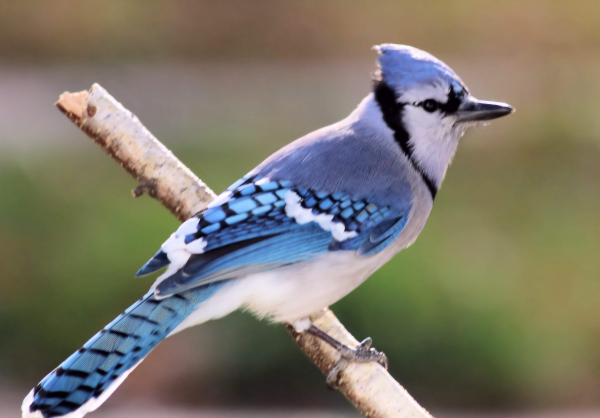
Blue Jays are one of the primary species affected by the mystery pathogen, along with fledgling Common Grackles, European Starlings, and American Robins.
|
The US Geological Survey’s National Wildlife Health Center (NWHC) and the Southeastern Cooperative Wildlife Disease Study (SCWDS) are currently working together to diagnose a mysterious ailment that has affected some fledgling songbirds – mostly Blue Jays, Common Grackles, European Starlings, and American Robins – in some Mid-Atlantic portions of the United States. To date, none of the labs have been able to identify the cause of the birds’ deaths.
After rigorous nationwide testing, the NWHC and its collaborators published a report that rules out several common bird pathogens, including West Nile virus, avian influenza, Newcastle disease, herpes viruses, poxviruses, salmonella, chlamydia, and trichomonas parasites.
While it’s extremely helpful to narrow down the list of potential pathogens, investigators are still searching for leads as to the cause of the bird deaths in areas of the Mid-Atlantic states from New Jersey to Virginia, plus West Virginia, Kentucky, and Indiana.
With such a broad spectrum of bacteria, fungi, toxins, and viruses to test for, it may be a while before researchers have a definitive answer. Nicole Nemeth with the SCWDS, said it’s even possible that the disease could be caused by multiple pathogens. “There’s really still a lot of possibilities,” she explained, “Unfortunately, it just takes time.”
Stopping the Spread
Until then, concerned citizens in affected regions can take steps to protect birds in their own yards. “The best thing we can recommend is taking down your bird feeders,” wildlife researcher Christine Casey said. Once down, it’s important to clean feeders and birdbaths with a 10 percent bleach solution to kill any pathogens, followed by a thorough rinse and drying time. Keeping feeders and birdbaths clean, of course, is standard procedure for most birders anytime, including the use of very diluted 10 percent bleach with thorough rinsing afterward.
When birds congregate in one place, it increases their chances of spreading disease. “The birds that have been seeing the symptoms are birds that tend to come to feeders,” said David Curson, director of bird conservation at Audubon Mid-Atlantic, referring mostly to jays, grackles, and starlings.
However, because it appears hummingbirds are not being affected, it should be noted that birders may want to use judgement about which feeders should be removed. Usually, the primary species being affected – jays, grackles, and starlings – are most apt to feed at bird feeders stocked with sunflower seeds, millet, nuts, and corn, as well as suet feeders. In short, if Blue Jays, Common Grackles, or Eurpean Starlings are attracted within the Mid-Atlantic area of concern, remove that food source and the feeders where the food is provided. Also, increase your level of feeder sanitation wherever you live, and keep the area beneath and around the feeders clean too.
If birders are concerned about removing a food source that birds that visit their feeders rely upon, keep in mind that feeders are only auxiliary food sources. Remember that at this time of the year many birds that visit feeders are more reliant on invertebrates for food, including insects, insect larvae, and spiders. During the nesting season, nestlings and fledglings need a lot of protein for rapid growth, provided by the adults, while adult birds also ingest an abundance of insect- and spider-based protein while it’s available.
It is noteworthy to share that one thing seems to be helping: When the NWHC, in partnership with state regulatory agencies, issued a request for birders to remove feeders in several Kentucky, Maryland, Virginia, West Virginia, and Pennsylvania counties, it seemed to be helping, with reports of sick birds dropping during recent weeks according to Casey. As long as that trend continues, “we don’t think this is going to potentially have long-lasting population-level effects,” she added.
Removing bird feeders has dramatically curb House Finch eye disease outbreaks. Cleaning birdbaths and feeders regularly also prevents salmonella growth. Assuming the mystery pathogen spreads similarly, these small actions could go a long way to keep birds safe. “Basically we’re recommending social distancing for birds,” Curson said.
Or maybe it’s that this summer’s cicada activity is winding down . . . To learn about a theory that draws a connection between the massive hatch of cicadas in the East with the infections of fledgling jays, grackles, starlings, and robins, you can refer to https://www.audubon.org/news/scientists-still-searching-pathogen-behind-easts-songbird-epidemic , which is the Audubon article that provided most of the information provided above.
For additional information, you can also refer to https://abcbirds.org/article/mid-atlantic-bird-illness-investigated/
And you can see the short news release provided by the USGS at https://www.usgs.gov/news/updated-interagency-statement-usgs-and-partners-continue-investigating-dc-area-bird-mortality
Share your backyard birding experiences and photos at editorstbw2@gmail.com